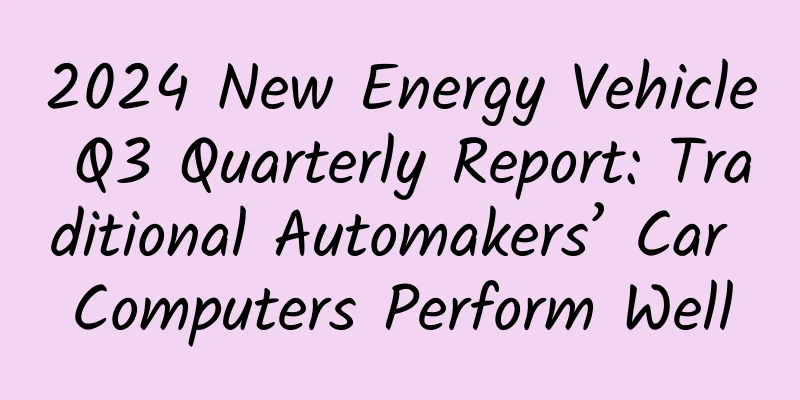2024 New Energy Vehicle Q3 Quarterly Report: Traditional Automakers’ Car Computers Perform Well

|
2024 has quietly come to an end, and the new energy vehicle industry continues to be exciting and transformative. We see more and more CEOs of car companies flocking to the live broadcast track to compete for this "overwhelming traffic". We have also witnessed the various strategies of car companies to survive and break through in the fierce competition, from incubating sub-brands to launching low-priced product lines, all of which reflect the current state of the industry where "volume" is the top priority and "survival" is paramount. With the end of the National Day holiday, Master Lu's 2024 new energy vehicle Q3 quarterly report was released as scheduled. Let's take a look at which models can stand out in our tests. Car machine smoothness list : the new Blue Mountain car machine is an excellent example, while the Model Y car machine performance is at the bottom According to the list, Wei's new Blue Mountain 2025 model ranked first with 275.3 points. It is equipped with the third-generation AI smart cockpit system Coffee OS 3 and the Snapdragon 8295 chip. When processing user commands, it not only has excellent response speed and stability, but also can remain smooth in complex operations. Its voice test almost achieved instant response, which is indeed a model of excellent car machine. Ideal L9 and Xiaomi SU7, also equipped with Snapdragon 8295, followed closely behind, each bringing a unique experience to users. The Xiaomi SU7's Pengpai car computer performs well in terms of response speed and stability, especially in terms of voice commands. Navigation and music playback, pause and other functions can respond within 1 second. The disadvantage is that when completing commands, its car computer is sometimes fast and sometimes slow, and the stability is not high, so there is room for improvement. In addition, Tesla Model Y ranked last, and its car system response speed and voice capabilities were relatively poor, and the experience was not as good as other leading models. For example, if you want to open Youku and Mango Video, Model Y's car system takes 2.86s and 2.75s to respond respectively. Although the voice response test score of 1.33s is acceptable, its voice recognition ability is not smart enough and can only execute specific commands. For example, you need to say "play music" accurately to start music playback, but "play Bluetooth music" cannot be achieved. Voice Test Ranking : The overall voice recognition level still needs to be improved Without physical buttons, voice interaction in the car becomes increasingly important. Whether it is adjusting music, setting navigation, controlling air conditioning temperature, or adjusting seats, the accuracy and intelligence of voice commands directly affect our driving experience. However, judging from the list data, despite the continuous development of new energy vehicle technology, the overall voice recognition level still needs to be improved. Models with poor performance on the list, such as Toyota bZ3 and Tesla Model Y, have basic voice control rates of only 37.14% and 36%. As joint venture and foreign brands, they are not well adjusted for localization, and are inferior to domestic new energy vehicles in terms of both function richness and recognition speed. For example, Toyota bZ3 does not support adjusting the seat angle by voice while driving. If the driver wants to instruct the car computer to find a TV series for the co-driver to watch, it cannot be done. Tesla Model Y has a big shortcoming in basic information query, and it fails to search for radio stations, music, and videos. Imagine that the voice does not work well, and you have to poke the screen with your hands while driving. It is really not good... Electricity consumption test list : Tesla Model Y runs less than 5 cents per kilometer in the city Tesla Model Y, which performed poorly in terms of smoothness of the car machine and voice control, ranked first in the urban 100-kilometer power consumption ranking with a score of 10.1kWh/100km. Based on the average electricity price of 0.45 yuan/kWh for home charging piles, it only costs 4.55 yuan to run 100 kilometers, which is less than 0.5 cents per kilometer, showing a very high energy-saving advantage and is very suitable for urban commuting. Among domestic models, Xiaomi SU7 also performs well, with an urban power consumption of 11.5kWh per 100 km, which is a relatively energy-efficient level. The urban power consumption of Wenjie M7 is higher, reaching 16.5kWh/100 km. Although Wenjie M7 is an extended-range vehicle and seems to have no range anxiety, if you have more urban commuting scenes, you will definitely give priority to pure electric. This data shows that the pure electric range of this car is actually not enough, which may be the biggest shortcoming of Wenjie M7. In the ranking of high-speed power consumption per 100 kilometers, Xiaopeng G6 topped the list with a power consumption of 15.1kWh/100km, showing good energy consumption performance. Toyota bZ3 followed closely behind with a high-speed power consumption of 15.4kWh/100km. Overall, its power consumption per 100 kilometers is about 13.1kWh, which is slightly higher than the official 11kWh/100km, but the overall performance is still excellent. Tesla Model Y ranked third with a high-speed power consumption of 15.9 kWh/100 km, and a comprehensive power consumption of about 13 kWh/100 km, which is equivalent to about 7.69 km per kilowatt-hour of electricity, more than the official advertised 6.1 km. This is very energy-efficient for an SUV weighing 1.91 tons. Charging efficiency list : Xiaopeng G6 is "far ahead" Xiaopeng G6 755 Max, CLTC range 755km, battery capacity 87.5kWh, nameplate shows rated voltage 551V, rated capacity 159Ah, from 153 battery modules provided by Zhongxin Aviation connected in series. On a third-party charging pile, according to the standard of 1-80% SOC, it only took 38 minutes to charge, and finally ranked first with a charging capacity of 1.88kWh per minute, leading in charging speed. The charging efficiency second only to Xiaopeng G6 is Xiaomi SU7, Zeekr 007 and Zhijie S7, with a charging capacity of 1.68, 1.67 and 1.65 kWh per minute respectively. It only takes 36-39 minutes to charge from 1% to 80%. Smart rankings : Huawei takes the top two spots In terms of comprehensive intelligent performance, Huawei took the top two spots. We tested the top-end version of the Enjoy S9, which is priced at RMB 449,800, and the top-end version of the Smart S7, which is priced at RMB 349,800. The results showed that the Enjoy S9 led the pack with a total score of 631.3 points, 46.8 points higher than the Smart S7. As a "boss car", Xiangjie S9 performs well in the intelligent configuration of the cockpit entertainment scene. To improve comfort, the boss seat on the right side of the rear row supports "zero gravity mode", and the passenger seat can be folded forward to free up more legroom for rear passengers. At the same time, the seat has heating, ventilation, massage and other functions. Zhijie S7 ranked second. Test data showed that the model performed among the top five in cockpit, intelligent driving and other scenarios, especially in charging, where it won first place in the single category. Judging from the entire list, many models show a mismatch between price and intelligence level. For example, Dongfeng eπ008, priced at 216,600 yuan, has an intelligence level of only 379.2 points. The Deep Blue G318 four-wheel drive air suspension version is priced at 229,900 yuan, and its intelligence level is even lower, only 349.7 points. Not to mention the electric MINI COOPER SE Artist, which is priced at 239,800 yuan, but does not come standard with adaptive or full-speed adaptive cruise control, and the number of cameras and millimeter-wave radars is also less than that of models of the same level. Compared with them, the Leapmotor C16 and Lynk & Co 07 EM-P, which are priced at around 180,000 yuan, have more advantages in intelligent experience and functions. Nowadays, when consumers choose, they not only look forward to the appearance and interior, but also pay more attention to the actual intelligent experience and functions, which also puts higher demands on car companies.
As a winner of Toutiao's Qingyun Plan and Baijiahao's Bai+ Plan, the 2019 Baidu Digital Author of the Year, the Baijiahao's Most Popular Author in the Technology Field, the 2019 Sogou Technology and Culture Author, and the 2021 Baijiahao Quarterly Influential Creator, he has won many awards, including the 2013 Sohu Best Industry Media Person, the 2015 China New Media Entrepreneurship Competition Beijing Third Place, the 2015 Guangmang Experience Award, the 2015 China New Media Entrepreneurship Competition Finals Third Place, and the 2018 Baidu Dynamic Annual Powerful Celebrity. |
<<: If you want to play, play the most advanced one! The ultimate cost-effective tool is here!
>>: Is the touch bar on the new MacBook Pro a revolutionary experience or just a waste of time?
Recommend
These 4 strategies for promoting Xiaohongshu are a must-read!
Today, Xiaohongshu is increasingly becoming a bat...
"Weibo Marketing Traffic Generation System 3.0" builds a traffic generation system from 0 to 1, with a full practical demonstration
Training course content: Build a drainage system ...
What exactly is the “resonant copywriting” that leaders mention?
"Xiao Wang, your creative writing needs to r...
How does Tik Tok make you addicted?
The world of short videos has never been peaceful...
What qualifications are required for a knowledge-based payment app? What are the features?
WeChat, as the largest traffic portal on mobile t...
10 tech products that became popular before they were released in 2015
2014 was an exciting year, as we mentioned in our...
How do you start to create an offline event?
1. To organize a successful offline event , we ne...
From love to hate: Why did Microsoft abandon Nokia and WP brands?
After Microsoft completed the acquisition of Noki...
Soul User Operation System
Nowadays, stranger social networking is favored b...
The ability to “fall asleep as soon as you want” that everyone desires could actually be a disease?
When it comes to sleep, most people probably want...
Changsha tea tasting tea arrangement
Content: Changsha new tea arrangement appointment...
Useful Information | General Process for Online Event Operation and Promotion
There is no clear definition of operation and spe...
How to do content marketing well and let users come to you!
When making a product, content should be added to...
Magic Leap's core technology revealed
This article is reproduced from the WeChat public...
8 ways to build seed users, in-depth practical cases!
There are different approaches for different prod...









